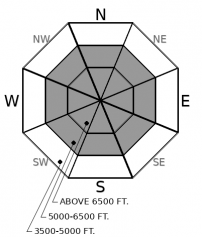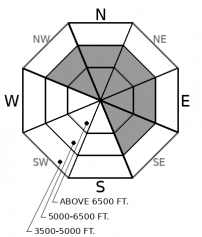| Sunday | Sunday Night | Monday | |
|---|---|---|---|
| Cloud Cover: | Mostly Cloudy | Mostly Cloudy | Mostly Cloudy |
| Temperatures: | 20 to 26 deg. F. | 12 to 18 deg. F. | 22 to 27 deg. F. |
| Wind Direction: | Southwest | Southwest | Southwest |
| Wind Speed: | 10 to 15 gusting to 35 | 20 to 25 gusting to 50 | 15 to 20 gusting to 55 |
| Snowfall: | 0" to 4" in. | 3" to 6" in. | 4" to 7" in. |
| Snow Line: | 1500' | 1000' | 1000' |
Whitefish Range
Swan Range
Flathead Range and Glacier National Park
How to read the forecast
Steep terrain near upper elevation ridgelines harbors avalanche hazards that have developed in the past few weeks. You can find safe riding that avoids these hazards on low angle, sheltered slopes at mid elevations. If you climb onto higher terrain that's more exposed to the wind, stick to slopes less than about 35 degrees. Shooting cracks and whumpfing collapses are clear signs you can trigger avalanches large enough to bury or injure you.

2. Moderate
?
Above 6500 ft.
2. Moderate
?
5000-6500 ft.
1. Low
?
3500-5000 ft.
- 1. Low
- 2. Moderate
- 3. Considerable
- 4. High
- 5. Extreme
-
Type ?
-
Aspect/Elevation ?

-
Likelihood ?CertainVery LikelyLikelyPossible
 Unlikely
Unlikely -
Size ?HistoricVery LargeLargeSmall

Elevation is the key to picturing the distribution of this hazard. Above about 6000 feet, you can trigger slabs that break 1 to 2 feet deep on weak snow around crusts and other weak layers buried during the Holiday week. The slabs grow thicker, stiffer, and more reactive to a person's weight as elevation increases. So tighten up your terrain choices and group management as you climb higher. Stick to slopes less than about 35 degrees that have runouts free from gullies, rockbands, and trees. You may need to dial slope angles back to 30 degrees or less as you approach summits and exposed ridges. Whumpfing collapses are an unambigious sign of danger.
-
Type ?
-
Aspect/Elevation ?

Aspect is the key to picturing the distribution of this hazard. Saturday's powerful southwesterly winds scoured snow from southerly and westerly slopes at mid and upper elevations, loading and crossloading sheltered slopes with drifted snow. People reported small to large natural and triggered avalanches involving the drifted snow. Today, llook for slabs of dense snow on the sheltered sides of ridges, gullies, rock outcrops, and other terrain features that collect drifting snow. These slabs can be dangerous on steep slopes where they're more than about a foot thick, or above terrain traps. If they're hard and sound hollow, they can break well above you. Cornices cantilevered over a slope are a sign of fresh wind loading. Steer clear of these slopes, as well as the cornices themselves, which may break surprisingly wide or far back from ridge crests.
Despite the brown, dry valley floors, a series of storms has dumped substantial snowfall in mid and upper elevation terrain in the past two weeks or so. SNOTELs above 6000 feet have recorded 4 to 5 inches of Snow Water Equivalent in the past week, and 6 to 10 inches of SWE since the Solstice. That amounts to 30 to 40 percent of the season's snowfall so far. Some dramatic weather punctuated the storms, including brief inversions, a freezing rain event, and gusty winds.
The storms and the weather swings left thick slabs broken by several potential failure planes - rain crusts, low-density snow, surface hoar, near-surface facets, and slick wind drifts. While these potential failure planes aren't distributed consistently through the forecast region, they're generally more widespread above about 6000 feet and in the northern and eastern quadrants of the forecast region. So as you move higher, the danger of triggering slabs that break on these layers becomes more of a concern, and the potential size of triggered slides grows. We've had numerous reports of slides or signs of instability on these layers, including: Whitefish, Swan, Glacier National Park-Lake McDonald area, Glacier National Park-John F. Stevens Canyon.
While the past two week's weather may have created new avalanche concerns, it also appears to have laid an older one - the mid-November crust - to rest. We've had no reports of triggered or natural slides on that layer since Dec. 20, though visibility has limited observations. We've removed Deep Persistent Slabs from the avalanche problems list. Given the the uncertainty, however, it's probably still worth avoiding very steep slopes with inconsistent snow depths and numerous trigger points.
The most recent punctuation in our weather story was Saturday's powerful winds. Gusts peaked at 50 to 70 mph at upper elevations, and 30 to 40 mph in the valleys. In addition to snapping trees, the winds picked up any dry snow that wasn't glued down, and drifted much of that into slabs up to a foot thick that were reactive to a person's weight across the forecast region Saturday. We had reports of shooting cracks, and small triggered and natural slides. These reports came from below 7000 feet. These freshly formed slabs will remain a hazad today. Expect them to be larger, harder and more more unpredictable at upper elevations.
After a break this morning, snow showers and gusty winds should return to the forecast region. The snowfall won't amount to more than a few inches, though the Swan Range could wring 3-8" out of the clouds. Another round of snowfall starts Monday morning, and steady snowfall should continue into midweek. Wind speeds and direction will vary with elevation today. Expect light to moderate southwesterly winds at mid elevations, and stronger, more westerly winds near exposed ridges and summits. The winds will likely remain moderate with strong to extreme gusts into midweek.
This forecast applies only to backcountry areas outside established ski area boundaries. The forecast describes general avalanche conditions and local variations always occur. This forecast expires at midnight on the posted day unless otherwise noted. The information in this forecast is provided by the USDA Forest Service who is solely responsible for its content.































